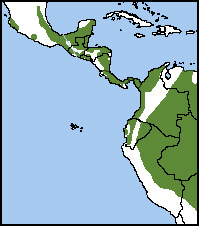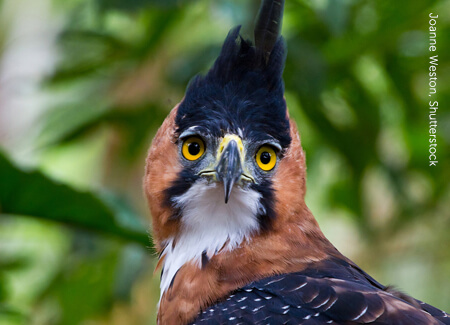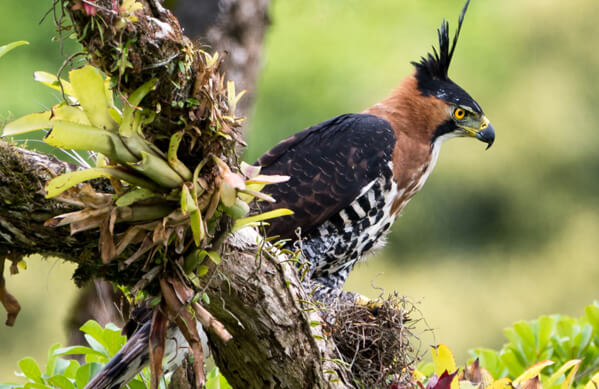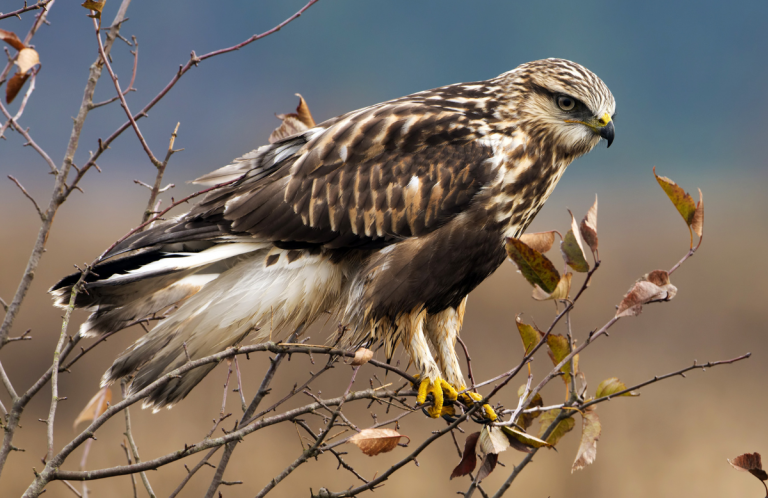 The Ornate Hawk-Eagle is aptly named, with piercing golden eyes and striking black, white, and chestnut plumage. This extraordinary raptor also has a crest of long black feathers, which the bird may keep flattened or held erect when excited. The birds are often seen soaring high above the rainforest canopy on broad, short wings while giving their repeated piping calls.
The Ornate Hawk-Eagle is aptly named, with piercing golden eyes and striking black, white, and chestnut plumage. This extraordinary raptor also has a crest of long black feathers, which the bird may keep flattened or held erect when excited. The birds are often seen soaring high above the rainforest canopy on broad, short wings while giving their repeated piping calls.
The primary threat to this species is accelerating deforestation, particularly in the Amazon basin, where it is projected to lose up to 40 percent of its habitat.
Although Ornate Hawk-Eagles are somewhat sensitive to habitat fragmentation and the presence of humans, they will tolerate some disturbance and have been documented nesting in relatively small patches of forest near human settlements. They are sometimes hunted by humans, who consider the raptor a threat to their poultry.
Hunting Habits of the Ornate Hawk-Eagle
While not as large as the Bald or Golden Eagles of North America, the Ornate Hawk-Eagle is a powerful raptor that can capture prey almost twice its weight. It feeds mostly on birds, including larger species such as curassows, tinamous, and guans, but it will also take small- to medium-sized mammals such as kinkajous, agoutis, squirrels, and rats, as well as large lizards and snakes.
Like the Harpy Eagle, the Ornate Hawk-Eagle is a predator of the forest interior. It hunts by sitting quietly on an inconspicuous perch then pouncing on its prey, whether in trees or on the ground.
Sign up for ABC's eNews to learn how you can help protect birds
Courtship and Cooperation
The species has a relatively long courtship period that begins one to two months before egg-laying and involves aerial displays and calling. A pair of Ornate Hawk-Eagles will work together to build a bulky nest of sticks and vegetation high in the canopy. The pair may re-use the same nest from year to year.
Unlike many other raptor species, Ornate Hawk-Eagles usually lay only one egg per clutch, which the male and female take turns incubating. Both care for the growing chick through its second year.
Because so much time is invested in care of their young, this species usually breeds only every other year. Its low reproductive output means that the length of time required to recover from population declines is greater than in other similar species.
 Juveniles look very different from adults, with white head and underparts and brown-black wings. They reach full adult plumage after two to three years.
Juveniles look very different from adults, with white head and underparts and brown-black wings. They reach full adult plumage after two to three years.
Providing an Eagle Haven
The Ornate Hawk-Eagle ranges through Central and South America, including Ecuador's Buenaventura Reserve, established in 1999 by ABC partner Fundación Jocotoco. Now encompassing more than 5,583 acres as a result of acquisitions supported by ABC and others, the reserve boasts a lodge and trail system where visitors can look for this forest raptor and other threatened species, including the El Oro Parakeet and Long-wattled Umbrellabird. (More information on visiting Buenaventura can be found here.)
ABC partnered in 2016 with World Land Trust to support Jocotoco in the purchase of a 233-acre addition that expanded the Buenaventura Reserve. The successful acquisition provided more habitat for the El Oro Parakeet and the species that share its habitat, like the Ornate Hawk-Eagle.
Donate to support ABC's conservation mission!



















































